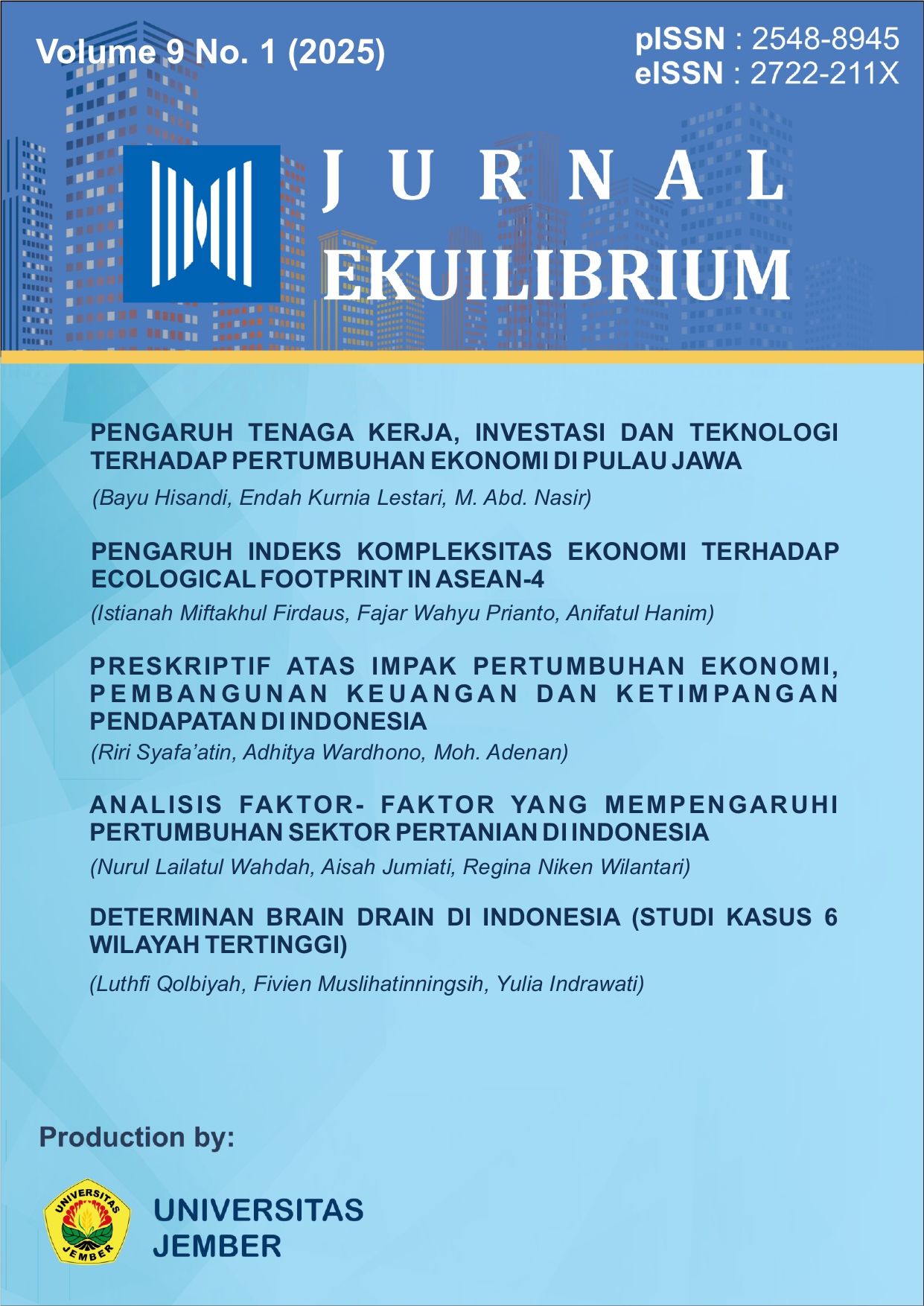PRESCRIPTIVE ON THE IMPACT OF ECONOMIC GROWTH, FINANCIAL DEVELOPMENT AND INCOME INEQUALITY IN INDONESIA
DOI:
https://doi.org/10.19184/jek.v9i1.46422Keywords:
Economic Growth, Financial Development, Income Inequality, IndonesiaAbstract
Income inequality dominates the economies of developed and developing countries. The effectiveness of economic growth and financial sector development is considered capable of encouraging the economy which will ultimately bring prosperity to society. This research aims to look at the impact of economic growth and financial development on income inequality in Indonesia. The method used is a descriptive method. This research uses domestic credit to the private sector carried out by banking, foreign investment (FDI) and M2; GDP per capita growth as a measure of economic growth and the Gini index as a measure of income inequality. The research results show that economic growth and financial development are growing in line with positive growth performance, even though income inequality rates fluctuate low.
Downloads
References
Badan Pusat Statistik. 2023. Gini Ratio Menurut Provinsi dan Daerah 2022-2023. Jaakarta.
Batuo, M. E. (2010). Financial Development and Income Inequality: Evidence from African Countries.
Claessens S, Perrotti E (2007) Finance and inequality: channels and evidence. J Comp Econ 35(4):748–773.
Chang, J. Y., & Ram, R. (2000). Level of development, rate of economic growth, and income inequality. Economic Development and Cultural Change, 48(4), 787-799.
Fernandez, M., Almaazmi, M. M., & Robinson, J. (2020). Foreign direct investment in Indonesia: an analysis from investors perspective. International Journal of Economics and Financial Issues, 10(5), 102.
Galor. O., and Zeira. J. (1993). Income Distribution and Macroeconomics. Review of Economic Studies, Bol. 60, pp. 35-52.
Goldsmith, R. W. (1969). Financial structure and development. New Haven, Conn: Yale University Press.
Gonzales, M., & Menendez, A. (2000). The Effect of Unemployment on Labor Earnings Inequality: Argentina in the Nineties. Working Papers, 216. Princeton University, Woodrow Wilson School of Public and International Affairs, Research Program in Development Studies
Hossain, A. (2005). The Granger-causality between money growth, inflation, currency devaluation and economic growth in Indonesia: 1954-2002. International Journal of Applied Econometrics and Quantitative Studies, 2(3), 45-68.
Hoi, L. Q., & Hoi, C.M. (2013). Financial sector development and income inequality in Vietnam: Evidence at the provincial level. Journal of Southeast Asian Economies, 30(3), 263–277.
Johnson, L. H. (1953). Limitations of the descriptive method. The Phi Delta Kappan, 34(6), 241-245.
Khatatbeh, I. N., & Moosa, I. A. (2023). Financialisation and income inequality: An investigation of the financial Kuznets curve hypothesis among developed and developing countries. Heliyon, 9(4).
Kuznets, S. (1955). Economic Growth and Income Inequality (Vol. 45, Issue 1).
Kuznets S. (1976), Wzrost gospodarczy narodów, produkt i struktura produkcji, Warszawa, original version: Economic Growth of Nations. Total Output and Production Structure,Cambridge Mass 1971.
Yang, Y., & Greaney, T. M. (2017). Economic growth and income inequality in the Asia-Pacific region: A comparative study of China, Japan, South Korea, and the United States. Journal of Asian Economics, 48, 6-22.
Younsi, M., & Bechtini, M. (2020). Economic growth, financial development, and income inequality in BRICS countries: does Kuznets’ inverted U-shaped curve exist?. Journal of the Knowledge Economy, 11, 721-742.
List, J. A., & Gallet, C. A. (1999). The kuznets curve: What happens after the inverted-U? Review of Development Economics, 3(2), 200–206.
Mustika, C., Haryadi, H., Junaidi, J., & Zamzami, Z. (2022). The Relationship Between Absolute Poverty Income Inequality in Rural and Urban Areas in Indonesia: The Granger Causality Approach. Jurnal Ekonomi Pembangunan, 11(2), 107-118.
Özdemir, O. (2019). Rethinking the financial kuznets curve in the framework of income inequality: Empirical evidence on advanced and developing economies. Economics and Business Letters, 8(4), 176–190.
Park, Donghyun, and Kwanho Shin. 2017. Economic Growth, Financial Development, and Income Inequality. Emerging Markets Finance and Trade 53: 2794–25.
Rehman, H., Khan, S., & Ahmed, I. (2008). Income distribution, growth and financial development: A cross countries analysis. Pakistan Economic and Social Review, 46(1), 1–16.
Sehrawat, M., & Giri, A. K. (2018). The impact of financial development, economic growth, income inequality on poverty: evidence from India. Empirical Economics, 55, 1585-1602.
Seven U, Coskun Y (2016) Does financial development reduce income inequality and poverty? Evidence from emerging countries. Emerg Mark Rev 26:34–63.
Schumpeter, J. A. (1911). The Theory of Economic Development. Cambridge, MA: Harvard University Press
Shahbaz, M., & Islam, F. (2011). Financial development and income inequality in Pakistan: An application of ARDL approach. Journal of economic development, 36, 35–58.
Shin, I. (2012). Income inequality and economic growth. Economic Modelling, 29(5), 2049-2057.
Siyal, G., Mohsin, A., Zaman, K. (2014), Financial soundness and Pakistan’s economics growth: Turn on the light. International Journal of Economics and Empirical Research, 2(9), 359-371.
Stiglitz, E. J. (2015). Inequality and Economic Growth. Rethinking Capitalism, 86(S1), 134-155.
Tan, H. B., & Law, S. H. (2012). Nonlinear dynamics of the finance-inequality nexus in developing countries. The Journal of Economic Inequality, 10, 551-563.
Tekin, Ä°., & Cengiz, O. (2017). Nexus between Financial Development and Inequality: An Empirical Investigation of Financial Kuznets Curve for Selected EU Countries. In The Empirical Economics Letters (Vol. 16, Issue 7).
World Bank (2016). Financial Development. World Bank, Washington, DC
World Bank (2016.) Indonesia's rising divide. Washington, D
World Bank (2023), Poverty and Equity Brief. World Bank, Washington, DC
Downloads
Published
Issue
Section
License
Copyright (c) 2025 Jurnal Ekuilibrium

This work is licensed under a Creative Commons Attribution 4.0 International License.
Authors who submit their manuscripts to be processed for publication at JEK should agree with following points:
1. The author cannot withdraw the manuscript that has been proposed for processing until it receives an answer from the Chief Editor regarding the status of the scientific article manuscript (accepted or rejected for publication).
2. The publisher is not responsible for plagiarism cases for articles published on JEK.
3. The publisher is not responsible for the data and content of articles published on JEK, and is entirely the responsibility of the author.
4. Authors whose articles are published on JEK agree to the following CC-BY license.

JEK by University of Jember is licensed under a Creative Commons Attribution-NonCommercial 4.0 International License.



